It is not uncommon to come across screw-top liquor bottles from the 20th century that are boldly embossed on their shoulders or bases with the above text. After Prohibition was repealed on December 5, 1933, US laws once again allowed the legal manufacture and sale of alcoholic drink. Liquor was legal but producing it was subject to greater Federal control.
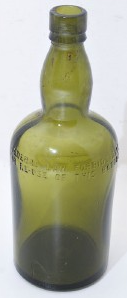
With its cork top, you might think this bottle is older than it is. With its FEDERAL LAW FORBIDS embossing, we can date it from the 1930s to 1960s
One law required that alcoholic bottles must be embossed with the text, “FEDERAL LAW FORBIDS SALE OR REUSE OF THIS BOTTLE” This law went into effect in 1935 and was repealed on December 1, 1964. Here is a direct link to the Office of the Commissioner of Internal Revenue – Alcohol and Tobacco Tax Division document. Here’s a link to the Federal Register from 1949 which outlines the law requiring this embossing – see section §175.8. The reason for this legislation is fairly obvious: after over a decade of Prohibition, law enforcement was well aware of the illegal trade in alcohol (bootlegging) and wanted to prevent the refilling of bottles by black market businesses.
Jack Sullivan, in an article called ‘ “Nasty Words” and Nifty Whiskeys‘ suggests that one unintended impact of this legislation was to “discourage distillers from putting their legitimate products in “fancy” containers as many had done prior to Prohibition.” Unfortunately, he provides no proof of this. It seems to me that there was simply a change in bottle styles thanks to the automated bottling machine and mass production techniques. The new distinguishing features in packaging came in the form of colorful labels with pictures and graphics.
As you can see in this document, the repeal of the legislation did not require that this marking of bottles cease immediately. Rather, it was simply no longer required. As you might expect, bottlers did not cease production on that very day. In fact, Bill Lindsey has documented one such FEDERAL LAW FORBIDS… bottle that he has accurately dated to 1974.
Federal Law PROHIBITS Sale or Reuse of this Bottle?
At times you will see references online to the words FEDERAL LAW PROHIBITS instead of FORBIDS. This is a persistent error which has been reported on some websites (including, we admit, on ours at one time), although the wording with PROHIBITS does not seem to exist on any bottle. Do you have a bottle embossed FEDERAL LAW PROHIBITS? Let me know – post a comment below with an image!
I have noticed regular auction listings on eBay where the seller lists the bottle with the word PROHIBITS but the photos clearly show the word FORBIDS. If you ask me this is a good example of the Mandela Effect where a large number of people remember something incorrectly and the error persists. I have been collecting long enough that I recall this error long before the Internet, but perhaps the online world has helped propel the myth along.
What may have started this trend, anyway? I have no proof, but I would suggest many associate this embossing with Prohibition, and the collective conscious of collectors simply got started on the wrong foot.
Value of bottles marked “Federal Law Forbids…”
If you come across such a bottle, you can date it in this time period. Such bottles do not yet hold much interest or value to collectors. However, if you come across one with good labels that have attractive graphics and it is in perfect condition, hold on to it. These are the collectibles of tomorrow.
Photographs of several “Federal Law Forbids Sale or Reuse…” bottles
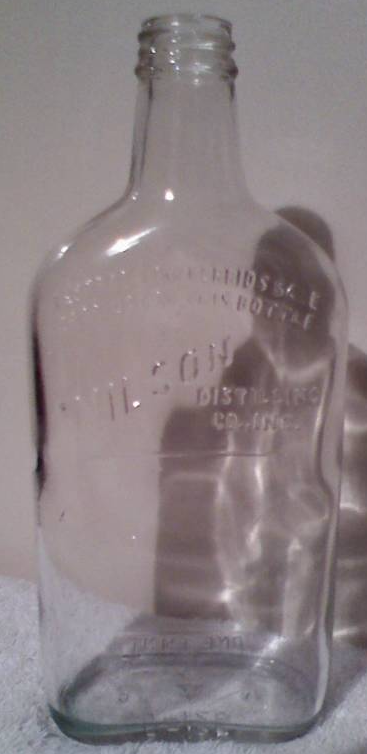
Typical example of a bottle that is marked Federal Law Forbids Sale or Reuse of This Bottle with screw cap, mold seam running to the top edge of lip and markings on the base.
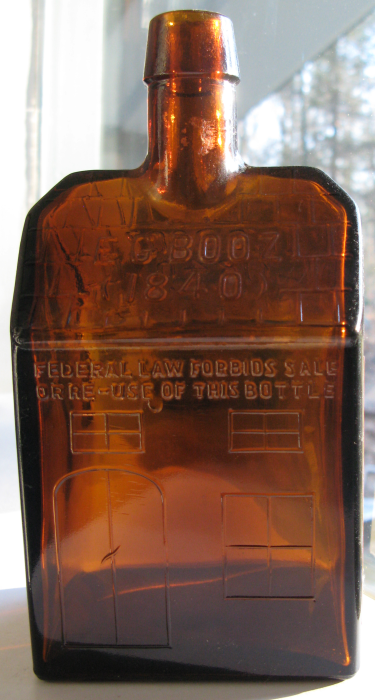
\’Federal Law Forbids\’ text on an EG Booz Old Cabin Whiskey bottle made by Armstrong Cork Company, Millville, NJ, 1954 to 1966
This last image shows the FEDERAL LAW FORBIDS SALE OR REUSE… embossing on the base of the bottle. Note the R-105 marking. The R stands for Rectifier; on other bottles you may see a D-[number] where D indicates Distiller. The 58-56 marking indicates the date of the bottle, which was also required by law. See The Code of Federal Regulations of the United States of America, pp. 23-25 for more information.
A direct quote from the regulations: “There shall be blown legibly either in the bottom or in the body of each liquor bottle the permit number of the manufacturer, the year of manufacture (which shall be indicated by the last two numerals), and a symbol and number assigned by the Commissioner to represent the name of the bottler procuring the same…”
For the bottle above, the year of manufacture would be 1956, presumably 58 is the permit number and 105 is the identifying number of the bottler.
Many bottles will be marked following this pattern, ie. a D or R along with 3 other numbers. I have noticed that some bottles that do not follow this pattern; at this time, I am not sure how to interpret the meaning of the markings in such cases.
Federal Law Forbids… Text on Labels?
I have found at least one suggestion online that the FEDERAL LAW FORBIDS… text may have appeared on labels rather than embossed on the bottle itself. Have you seen such an example? If so, please get in touch, I would like to see a photograph
Replica / Facsimile Labels on Federal Law Forbids bottles
Recently (as in 2025) I discovered a seller on eBay who offers for sale early 20th century liquor bottles marked with the Federal Law Forbids text onto which he has applied modern replica or facsimile labels. Unfortunately the labels bear no mark indicating that they are new or applied – some are more obviously believable than others. Some appear to be copies of old labels which may or may not be authentic to a specific bottle. I have long used the process of seeking out labeled examples to build a spreadsheet of Distiller and Recitifier numbers, connecting these numbers to specific brands and bottlers. Be cautious when making such connections.
References:
The Illustrated Guide To Collecting Bottles, Cecil Munsey. 1970.
Internal Revenue Service, Industry Circular, #64-18, October 23, 1964
Tippecanoe and E. G. Booz Too!, Tom Haunton, self-published, 2001, 2003
ORDER BANS REUSE OF LIQUOR BOTTLES; Treasury Issues Regulations, Effective Aug. 1, for Blown-In Markings. New York Times, July 15, 1934
LIQUOR BOTTLE RULES ARE EFFECTIVE TODAY; Marking of Containers and Destruction When Empty to Be Enforced Strictly. New York Times, January 1, 1935
RUM-RUNNERS AGAIN CHALLENGE THE LAW; From Their St. Pierre Stronghold They Resume Their Old Trade in a New Way, New York Times, January 13, 1935
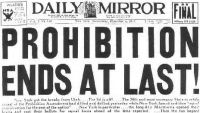
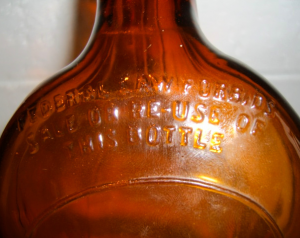
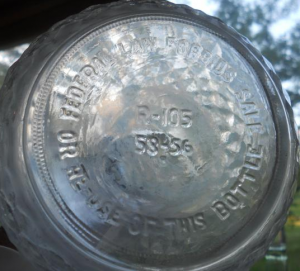
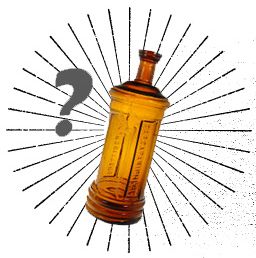
Kacie on said:
Just curious about some old bottles, I found if my grandfather’s, as I was cleaning and going through his collection of old tea pots, bottles, etc.
Christopher Woods on said:
You should post some group pictures on the discussion forum.
http://forum.antiquebottles-glass.com
Sarah Livingston on said:
I think my bottal is very rare it has a tear drop glass cork on is painted with gold around a masonary mark it is green tinted please let me know I will send pics if need be
Patrice B. on said:
Please tell me something about these glass containers. There are three, with one of the stoppers being a bit smaller. They have gold bands around the neck. The bottom says,”Federal law forbids…” And what looks like a circle, a “D”, and 90-56. There is a small oval shape on the front that looks like a place to put a label, that measures one inch by two inches. The bottom has a raised area like you would use in service of good wine. I remember them on the household’s bar in the 50’s, 60’s, and 70’s. Any value to them?
Christopher Woods on said:
They may have some minor decorative value, but in my opinion interest is limited to examples with fancy embossing or fancy label…better yet, sealed with contents
amy m on said:
Hello there- I’ve been hanging on to an E.G. Booz bottle and each time I research, I get mixed messages on its era/worth. It has the same “federal law forbids” text on it as the photo above and the bottom has 7D61 12A54 followed by a 4. It seems to fall into the 1954 era, but i’m unsure. Would love to know your thoughts. Much appreciated!
Christopher Woods on said:
I cannot see the entire bottle but the front label at least appears to be worn in places. There are no tax stamps present, nor is the foil seal or cork there…so it is not a best possible example. These are fairly common so my feeling is no more than $10-20 value.
Tom Haunton, who wrote the book on this bottle, dates this one definitively – mid 1950s to mid 60s
Christopher Woods on said:
See also my page on the EG Booz bottles.
Jeff Yeager on said:
I found a clear, half pint bottle in a opening of an old tree on a old dirt road. It has a metal screw cap, and on the bottom it says D-2 40-56. Right under the neck it says Federal Law Forbids Resale or Reuse of this bottle. Can you give me any info on this bottle?
Christopher Woods on said:
I have connected D-2 to the “Old Quaker” brand. Likely 1950s era.
Devaughna R Summers on said:
I have a blue and gray milk glass marble decanter that I am pretty sure is from Jim Beam Whiskey. however, the bottom is embossed with D-334, below that is 118 71 and below that is the number 5. When I researched other decanter’s similar to mine, the stamping on the bottom was completely different than mine. ??????
Christopher Woods on said:
These are manufacturer marks which could represent lot numbers, molds or all sorts of unknown information. I would expect variation.
I do see a fair consistency in the D-xxx and the R-xxx numbering of “FEDERAL LAW FORBIDS…” marked bottles since this is meant to represent a particular Distiller or Rectifier. However, I have found some variation even there on a few examples.
Teoni Black on said:
Thanks, now i know what year these bottles are that i find at an old ranch dump near by. They all seem to be from the 50’s. I noticed the liquor bottles say “federal law forbids” and the old E&J Gallo wine bottles say “Refilling Prohibited” on the bottom.
Lynn on said:
I found a Laird Full quart screwtop brown/Amber bottle washed up on the beach a couple of years ago and have had it on display. Would love to know what it is. The numbers on the bottom are D – 60 And there is a 7 running sideways and the number 9 41 with an anchor? Between the 9 and 41. Any help would be appreciated !! Thanks
Christopher Woods on said:
Sorry, I have no info on the D-60 marking…this is the key to finding out the manufacturer. Sometimes one can scan ebay bottles for the D number and find a match…
Dawn on said:
Can you tell me what this bottle is?
Thank you
Christopher Woods on said:
The only ways that I know to identify such bottles is either (1) by the D-xxx or R-xxx number on the base. (I have been slowly building a database of these numbers to identify the manufacturer / brand) or (2) Roll up your sleeves and start looking for examples with a label. I frequently scan the offerings on ebay in both the bottle categories and the advertising category.
Ryan on said:
I have a glass pitcher that has these Whisky Bottle post prohibition markings. Believe D-126 is Seagrams Brand Lord Calvert Whisky from 1961. Can you tell me anything about an open top pitcher with a fill line. Pics attached. Thanks for your website..great information.
Christopher Woods on said:
Correct – my info says D-126 is Seagrams / Calvert. I am not familiar with this pitcher. One thing to add: It is my understanding that the “FEDERAL LAW FORBIDS..” embossing was for bottles with contents. This would suggest your pitcher was sold with contents originally….
Loribeth on said:
I have that same bottle, except mine is from 1958. I’ve never seen another one like it until now!
Tim on said:
I’m glad to have stumbled onto your site as it helped me identify this bottle as a 1956 Kentucky Tavern Whiskey bottle. Along with the “Federal Law Forbids…” the numbers on the bottom are: 55 56 D-8. When I was young my mother would keep wine it, so that’s what I had always assumed its purpose was. When she passed away I held on to it for sentimental value, yet always wondered just how old it was. And now I know. Thank you.
Diana Delamater on said:
Clear glass bottle says, federal law forbids resale of this bottle, D-8, 11955, about 14″ high clear glass with cork stopper and either gold or brass around the neck
Christopher Woods on said:
I find that D-8 identifies Kentucky Tavern Whiskey (brand), Glenmore Distilleries, Owensboro, KY (company) Your bottle likely dates from the 1950s or 60s.
Carlos Martinez on said:
Would to know the value of my D-126 whiskey bottle and would like to know the meaning of the embossing: D-126 4166 6 61. Thank you.
Christopher Woods on said:
The “D” on the base is short for Distiller – this is a manufacturer number used during the period when this Federal Law was in place. I have connected #126 with the Seagrams company and their Calvert Whiskey brand.
The other numbers were used by manufacturers and there is not a whole lot known – it is possible your bottle dates to the 1960s based on the “61” value but one cannot be sure.
Bill Parisian on said:
I have a Lord Calvert blended whiskey bottle with federal law forbids sale or reuse of this bottle. It has good labels on it, the back has a Calvert recorded number (FQ27042) and a Michigan liquor control sticker and an Internal Revenue sticker across the cap. Both stickers have numbers on them. Is there any way to date this bottle or estimate its value.
Brandon on said:
i have a bottle that has ”federal law forbids sale or re use of this bottle” on it and it’s pink. But on the front it has i guy on a horse holding something and no name but their is a couple of numers on the bottom of it.
bob on said:
How much is my bottle worth? Its brown with a diamomd patern. And has a cork.
It also has a picture of a shield with a banner underneath the shield. And is missing labels. Is made in Philadelphia, P.A.. It also has the words ”federal law forbids sale
or re-use of this bottle.”
HistoricGlass on said:
This page addresses value in a general way. Please read my comments on value.
al on said:
what is my bottle worth?
clear glass, one pint, screw type top, embossed words on shoulder(federal law prohibits ETC..), i think it is called a dandy flask.
HistoricGlass on said:
I do address value in a general way in the “Value” section on this page. Rule #1: Most have no value at all. There are a minority that have rather fancy designs in the glass – couple that with original labels in good condition, preferably labels that have a multi-color graphic. Such exceptional pieces in like-new condition could be worth as much as $20-50 to the right collector. If in doubt, see Rule #1.